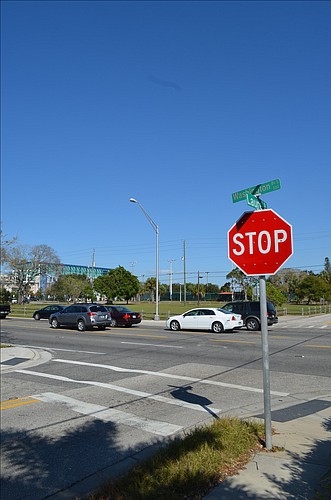- April 24, 2024
-
-
Loading

Loading

In writing a form-based code for the city, the Urban Design Studio has to work with residents with different levels of familiarity regarding the rules and principles that guide zoning. After decades of working to build desirable regulations for their neighborhood, Laurel Park residents tend to land on one end of that spectrum.
“We have a fairly educated group here,” Laurel Park Neighborhood Association President Kate Lowman said.
On Tuesday, the Urban Design Studio spoke at a Laurel Park Neighborhood Association meeting to begin implementing a new code in an area that has fought to establish its current code. Laurel Park sits on the edge of one of the group’s catalyst areas — segments of the city in which form-based code will be more immediately implemented, so residents can develop a familiarity with the concepts in play.
Presently, Laurel Park has a residential zoning designation unique to the area, with regulations governing elements such as porch and fence design. Most recently, the group successfully pushed for the creation of a Laurel Park Overlay District, which requires developers to hold public workshops before gaining approval for site plans that exceed zoning regulations.
Urban Design Studio Director Karin Murphy recognized the challenge in getting a neighborhood satisfied with current regulations to embrace an entirely new code. She assured residents the goal was not to change how Laurel Park looked and functioned, but to establish an easier-to-use and more consistent guideline for achieving similar results.
“We want to preserve the DNA, but we also want to share with you best practices that the current code lacks,” Murphy said.
In the short-term, the Urban Design Studio is focusing on improving the connection between the neighborhood and Payne Park across U.S. 301. Murphy said the group would work with the Florida Department of Transportation to gain approval to make changes to the roadway, to ultimately create a better pedestrian experience.
The changes would go beyond just adding crosswalks. Murphy and Principal Urban Designer Andrew Georgiadis criticized the shared left-turn lanes in the center of the roadway. The wider street encourages speeding, they said, and drivers do not use the turn lanes in a consistent manner. Getting changes approved on a highway would be a protracted process, but the urban design team had confidence it would be able to work toward creating a tamer roadway.
“We need to have more crossing opportunities between Payne Park and what's on the other side,” Georgiadis said. “There are a lot of obstacles to that, but there's nothing we can't handle.”
Although that specific proposal went over well with the audience, there was still a reluctance to whole-heartedly accept the idea of change. Resident Jolie McInnis said the changes presented at the meeting sounded good, but that the status quo was good, too.
“I think Laurel Park has worked very hard on our current zoning,” McInnis said. “It’s desirable, it’s walkable, it’s pedestrian friendly.”
Lowman, too, was wary about what future changes might have in store for the neighborhood. She acknowledged the current code was relatively convoluted, but said it worked for Laurel Park. She wanted assurance from the Urban Design Studio that any changes would emphasize maintaining the elements the residents liked, rather than starting over from scratch.
“There could be improvements, but it's kind of a delicate agreement that's been reached,” Lowman said.
Murphy said that is exactly what the Urban Design Studio intended to do.
“We want to do it right for each neighborhood,” Murphy said. “We love all the good stuff about Laurel Park, but we'd like to get you in a more uniform code, because the old one is very broken.”
Problem solving
After a series of complaints regarding illicit activity such as drug-dealing, Laurel Park residents were frustrated with their available options — so they are pushing to create new ones.
The Laurel Park Committee to Fight Back Against Nuisance Properties was created last year to see if there was something residents could do to address consistently problematic tenants in the neighborhood.
Headed by Chris Jaensch, the group has begun fighting for the creation of a process that would allow private citizens to bring cases in front of the city’s Nuisance Abatement Board.
“The board seems to prefer that the police drive that process, but it's hard without evidence,” Jaensch said.
Officer Tyler Rossnagle acknowledged it was often difficult for the police to make arrests based on residents’ complaints, but said it was important not to be discouraged by a lack of immediate progress.
“Just call us every time,” Rossnagle said. “With nuisance abatement, if you call and call and call, and they have a bunch of case numbers, they're going to take note of it.”
The committee aims to eventually provide a handout for residents with information about what to do when they have a recurring issue with a neighbor. The group is still in its earliest stages, but they’re optimistic about making progress.
“Hopefully we'll be able to come up with more answers as the year goes by,” Jaensch said.
Contact David Conway at [email protected]